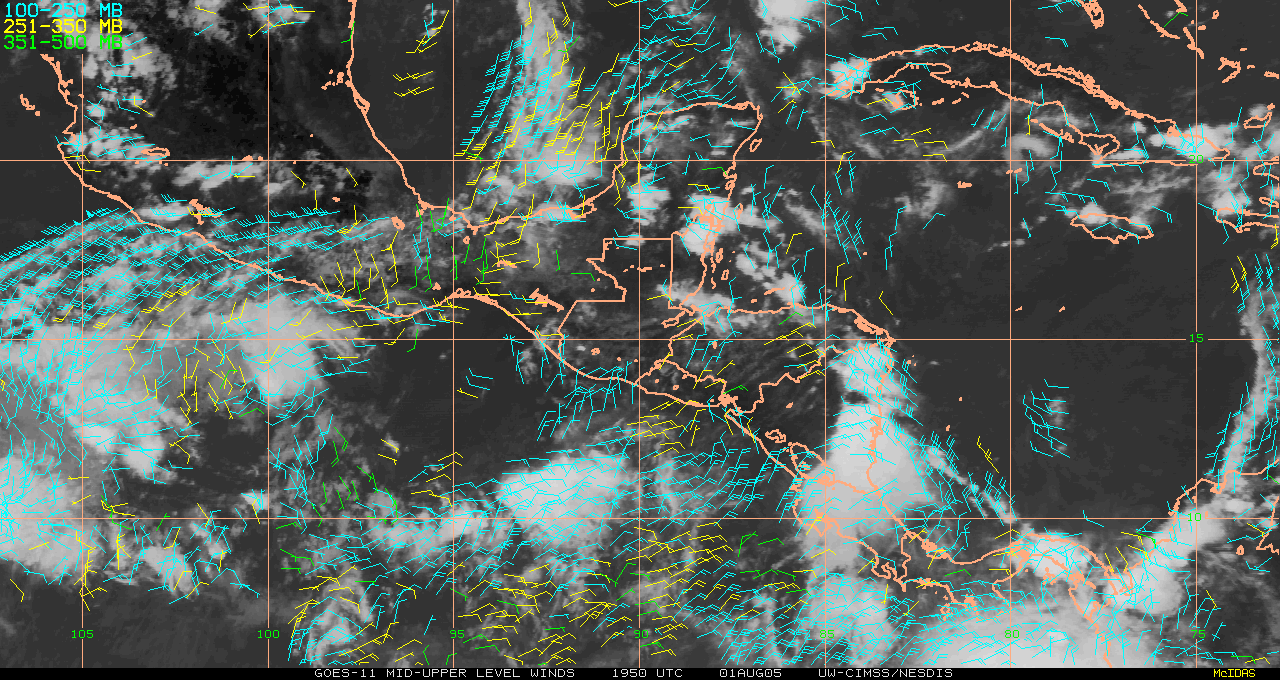TCSP GOES-11 Rapid Scan Winds
Table of Contents
Introduction
Geostationary satellite-derived wind sets have traditionally been generated from image triplets with 30 or 60 minute intervals, and occasionally 15 minute intervals. During GOES special rapid-scan operations, co-located images are available at intervals of 7.5, 5, 3, and even 1 minute. The area covered is reduced as the interval decreases. In this experiment images at five minute intervals were used for the 0.65 µm VIS, 3.9 µm IR (darkness only), and 10.7 µm IR channels.

GOES-11 was brought out of storage and image products were centered on the TCSP study region. Regular image processing was available beginning on 12 July. The scan schedule was maintained through the end of July.
These wind products were supplied by the Cooperative Institute for Meteorological Satellite Studies (CIMSS) at the University of Wisconsin-Madison Space Science and Engineering Center (UW-SSEC).
Campaign Description
The Tropical Cloud Systems and Processes (TCSP) mission was a field research investigation sponsored by the Science Mission Directorate of the National Aeronautics and Space Administration (NASA). TCSP was focused on the study of the dynamics and thermodynamics of precipitating cloud systems, including tropical cyclones using NASA-funded aircraft and surface remote sensing instrumentation. TCSP research specifically addressed the following topical areas:
- Tropical cyclone structure, genesis, intensity change, moisture fields and rainfall.
- Satellite and aircraft remote sensor data assimilation and validation studies pertaining to development of tropical cyclones.
- The role of upper tropospheric/lower stratospheric processes governing tropical cyclone outflow, the response of wave disturbances to deep convection and the evolution of the upper level warm core.
Instrument Description
The mission of the GOES spacecraft is to obtain observations of Earth’s weather and space environment (GOES I-M Data Book, 1996). The baseline constellation consists of two operational satellites and one satellite stored on-orbit. The operational satellites are deployed in a geosynchronous orbit 6.6 RE from Earth’s center at 75º and 135º west longitudes. The Earth Imager and Sounder are the primary instruments. Call-up of the stored satellite is dependent on a loss of meteorological data from these instruments.
GOES satellites provide the kind of continuous monitoring necessary for intensive data analysis. They circle the Earth in a geosynchronous orbit, which means they orbit the equatorial plane of the Earth at a speed matching the Earth's rotation. This allows them to hover continuously over one position on the surface. The geosynchronous plane is about 35,800 km (22,300 miles) above the Earth, high enough to allow the satellites a full-disc view of the Earth. Because they stay above a fixed spot on the surface, they provide a constant vigil for the atmospheric "triggers" for severe weather conditions such as tornadoes, flash floods, hail storms, and hurricanes. When these conditions develop the GOES satellites are able to monitor storm development and track their movements. The GOES provide frequent images at five different wavelengths, including a visible wavelength channel and four infrared channels. The satellites scan the continental U.S. every 15 min.; most of the hemisphere, from near the north pole to ~ 20S latitude, every 30 min; and scan the entire hemisphere once every three hours in their "routine" scheduling mode. Optionally, special imaging schedules are available which allow data collection at more rapid time intervals, over reduced area sectors. During Rapid Scan Operations (RSO) and Super Rapid Scan Operations (SRSO), imagery is collected over increasingly reduced-area sectors at 7.5-minute intervals (RSO) and at either 1-minute or at 30-second intervals (SRSO). RSO is a special imaging schedule that can be activated by any National Weather Service office for any situation it deems necessary.
Data Format
ASCII file name format:
tcsp_text.DD.MM.2005.[type].HH.out
DD - day of month
MM - month
HH - hour
[type] - type of wind (IR, SWIR, VIS)
Each ASCII file contains 12 columns of information:
1. type - type of wind
IR - imager cloud drift
SWIR - imager low level short wave IR
VIS - imager low level visible
2. sat - satellite
3. day - date (YYYYMMDD)
4. hms - nominal time of the wind set (HHMM, leading 0's not shown)
5. lat - latitude of wind vector (+ north, - south)
6. lon - longitude of wind vector (+ west, - east
7. pre - pressure height assignment for vector (mb)
8. spd - speed of the vector (meters per second)
9. dir - direction of vector
10. rff - CIMSS recursive filter quality control value
11. qi - EUMETSAT control value
12. ee - regression derived expected error value (meters per second)
Sample data file
| type |
sat |
day |
hms |
lat |
lon |
pre |
spd |
dir |
rff |
qi |
ee |
| IR |
GOES11 |
20050712 |
1600 |
24.32 |
96.87 |
262 |
11.3 |
181 |
70.30 |
0.59 |
2.89 |
| IR |
GOES11 |
20050712 |
1600 |
24.32 |
96.77 |
262 |
11.2 |
180 |
68.56 |
0.58 |
2.90 |
| IR |
GOES11 |
20050712 |
1600 |
24.30 |
95.87 |
312 |
8.9 |
176 |
57.87 |
0.58 |
2.95 |
| IR |
GOES11 |
20050712 |
1600 |
24.35 |
95.77 |
337 |
8.9 |
169 |
66.47 |
0.58 |
2.67 |
| IR |
GOES11 |
20050712 |
1600 |
24.35 |
95.64 |
793 |
11.5 |
162 |
78.58 |
0.50 |
2.82 |
File Naming
There will usually be 48 files/day, one dataset each hour, one with all winds, and one with only winds over water. Below are example files for both ASCII text wind products and GIF image wind plots.
Data examples:
tcsp_text.17.07.2005.nhir.17.out
tcsp_text.17.07.2005.nhvs.17.out
tcsp_text.17.07.2005.swir.11.out
<campaign>_<file type (text)>.<date (DD.MM.YYYY)>.<type (ir, swir, vis)>. <hour (HH).out
Browse examples:
17Jul2005-17z-lowerwindsg11.gif
17Jul2005-17z-upperwindsg11.gif
<date>_<time>-<lower or upper wind><inst>.gif
References
These GOES-11 rapid scan wind product plots can be viewed at the CIMSS TCSP GOES-11 RAPID SCAN WIND PRODUCT ARCHIVE web site: http://cimss.ssec.wisc.edu/tropic/tcsp/archive/g11winds.html
Contact Information
Data can be ordered and questions addressed at http://ghrc.nsstc.nasa.gov/.
To order these data or for further information, please contact:
Global Hydrology Resource Center
User Services
320 Sparkman Drive
Huntsville, AL 35805
Phone: 256-961-7932
E-mail: support-ghrc@earthdata.nasa.gov
Web: http://ghrc.nsstc.nasa.gov/
|

